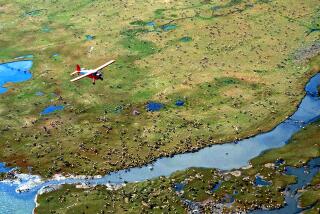A Senseless Scheme Aims at a Priceless Arctic Treaure : Environment: Opening the last north coast sanctuary to drilling would yield, at best, six months’ worth of oil.
The Arctic National Wildlife Refuge is the last protected fragment of the great coastal plain where North America slopes down to the polar ocean. More than 85% of this unique area is already open to oil exploration and development.
But apparently that is not enough.
Certain segments of the oil and gas industry, emboldened by electoral changes, are now asking for everything--for the right to invade our last Arctic sanctuary for the sake, even by the most optimistic estimates, of six months of national oil consumption.
I spent some time in the Arctic refuge in 1993. The tundra, a thousand shades of emerald and jade, sparkled in the soft light of the midnight sun. On a field of cotton flowers and saxifrage, musk oxen circled to protect their calves as a pack of wolves stalked nearby. It was late summer and the caribou had already trekked southward into the passes of the Brooks Range; the tundra was touched with the scarlet hues of autumn, and the snow geese would soon be coming down from Wrangell Island to fatten up before the long flight southward.
One night at Peters Lake, I read the words of author Barry Lopez: “Twilight lingers--the ice floes, the caribou, the musk oxen, all drift, the stillness, the pure light--you can feel the silence stretching all the way to Asia.”
Should Congress vote to end the longstanding protection of the heart of one of our premier wildlife refuges, it will inevitably shatter the balance of land and life into a thousand fragments.
Advocates of opening the Arctic refuge to oil development often have based their argument on national security. This argument is weak because no single oil discovery, even a large one, would fundamentally alter our nation’s oil security situation.
The Clinton Administration recognizes the importance of U.S. energy security and will continue to support steps that, as shown by past experience, can help us minimize the risks associated with short-term supply disruptions. Sacrificing the Arctic refuge is not one of them.
Drilling proponents also have tried to argue that exploring, producing and shipping oil on the fragile Arctic coastal plain can be accomplished without damage to the wildlife values that the refuge was established to protect.
But their “environmentally safe” argument is as as empty as the “national security” one. The Alaska congressional delegation wants to change the name of the Arctic National Wildlife Refuge to the “Arctic Oil Reserve.”
The American people will see right through this name change. They will understand that even those who are dedicated to opening this area to the oil industry recognize, correctly, that development will be its death knell as a wildlife refuge.
As their key arguments collapse, oil development proponents have resorted to arguing that opening the refuge would raise $1.4 billion for the U.S. Treasury over a five-year period. That revenue projection contains more than its fair share of wishful thinking. It assumes that the Treasury will get one-half of any lease sale revenue. Yet the state of Alaska maintains that it is guaranteed no less than 90% under the Alaska Statehood Act and is suing the federal government to confirm this principle. If that holds, the projections for the U.S. Treasury drop to $280 million.
Also, those numbers were based on the assumption that oil prices would rise. Instead, oil prices have dropped nearly 50% since 1987, when the Reagan Administration proposed leasing the coastal plain of the Arctic refuge. Then, oil prices in 2000 were expected to be $38.60 per barrel (adjusted for inflation and in 1995 dollars). Now, however, oil prices in 2000 are expected to be $19.13.
Lastly, new information has led the U.S. Geological Survey to conclude that earlier high estimates of petroleum resources should be revised downward.
In short, those who would open up the coastal plain can no longer argue on the grounds of national security, environmental safety or fiscal responsibility.
What’s most disappointing, though, is that they simply miss the larger, long-term and ethical vision. Opening the Arctic Wildlife Refuge to oil drilling is the equivalent of offering Yellowstone National Park for geothermal drilling, or calling for bids to construct hydropower dams in the Grand Canyon. We can, and surely will find a better way both to produce energy and to conserve our natural heritage.
More to Read
Sign up for Essential California
The most important California stories and recommendations in your inbox every morning.
You may occasionally receive promotional content from the Los Angeles Times.










